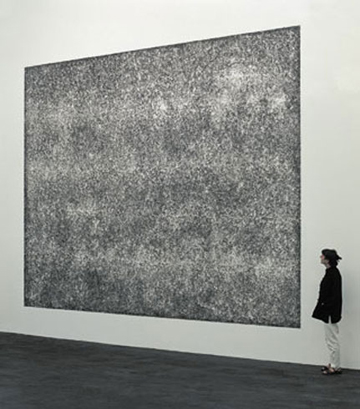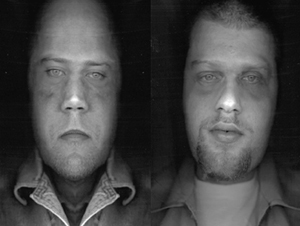









BEDROCK: SIX CONTEMPORARY ARTISTS FROM ICELAND
at Dalhousie Art Gallery, 7 July - 1 October 2000
(Anna Lindal, Birgir Andrésson, Hulda Hákon, Jón Óskar, Ragna Róbertsdóttir, Svava Björnsdóttir)
[First published as "Paradigm Lost: Icelandic Art in Halifax" by Winnipeg's Border Crossings magazine in issue 76, 2000, 73-74.]
Halifax is close to Iceland, at least by Canadian standards. Reykjavik's direct flights regularly deplane fine art students into Halifax's Nova Scotia College of Art & Design. Several Halifax artists participated in a 1997 gathering in Iceland called "ON-Iceland." The exchange continues in curator Sue Gibson Garvey's Bedrock: six contemporary artists from Iceland, Dalhousie Art Gallery's contribution to last summer's "HX," Halifax's first biennial-style festival of international contemporary art (Bedrock dates: 7 July-1 October 2000).
Bedrock's methodologies are those of internationalist contemporary art in Icelandic variations: Ragna Róbertsdóttir's large rectangle of volcanic bits of pumice glued directly to the gallery wall is minimalism with a fiery edge. Jón Óskar's flat-bed computer scanned faces look slightly drunk and menacing. Both works are technically innovative and portable - two defining traits (Richard Serra would disagree) of contemporary international art practice. Like Róbertsdóttir's and Óscar's art, Birgir Andrésson's text panels and Anna Lindal's multiple video screens exemplify how contemporary artists from far-flung places (I think of Halifax and Winnipeg) can speak both from within and without metropolitan culture. These artists address their rural homeland and its traditions through the contemporary urban sensibility I associate with an advanced degree in fine art.

Modernist artists such as Malevich and Picasso also made art that was alien to their traditional cultures, even as they made explicit references to (respectively) Russian Icons and Iberian sculpture. Modern life is divorced from traditional culture, and contemporary artists can only make reference to, but never actually make traditional art. Bedrock's Icelandic artists express a knowing distance from their own traditions: that's what the best contemporary artists do.
Contemporary art from Iceland can look "exotic." "Exotic" is a fraught word in post-colonial thought, today's dominant fad in literary and cultural studies. The "exotic" is what is brought back to the metropole from rural places so that "we" (you know who "we" are!) can subject it to ethnographic study. Calling something "exotic" betrays a cunning and greedy metropolitan attraction to a conflicted rural culture; to "exoticize" is to project desire onto a foreign place in order to satisfy an evil colonizing impulse. Or not.
Halifax and Winnipeg are "exotic" places too, but Iceland is much stranger, full of wonders like hot springs, volcanoes, and Norse sagas. (What's more exotic than that?) As Iceland's contemporary university-educated artists self-consciously mold this material, Dalhousie art gallery is turned into an ethnographic museum, a cabinet of Icelandic curiosities (Gibson Garvey hints at this in her catalogue essay) created not by anthropologists, but by a sympathetic curator and Icelandic natives who have gone to grad school.
Artists such as Róbertsdóttir and Óskar do Icelandic science-project-conceptual art. Ragna Róbertsdóttir's lava wall, mentioned above, is lit from one side to create long lunar shadows, each tiny rock plainly visible and capable of being examined minutely, as if for scientific study. A delightful pseudoscience is also at work in Jón Óscar's flat-bed computer scanned faces (also mentioned above). Óskar speaks to the science of genetics in a parody of physiognomy. His work, which requires that a face be placed flat on a flat-bed scanner, recalls Francis Galton's obsessive 19th Century search for such chimeras as the "criminal" face.
Hulda Hákon's text and animal paintings are as Icelandic as this show gets, but she explicitly denies that she "exoticiz[es] her own culture in relation to others." I disagree and would place her folk tales and animal paintings at the far end of the exotic scale.
Unlike Hákon, Svava Björnsdóttir does not revel in the exoticness of Iceland at all. Börnsdóttir's wall-mounted abstract paper sculptures resist attempts to position them within the exoticizing and ethnographic terms that come so quickly to mind in the presence of the other works in Bedrock. Björnsdóttir measures the exoticizing practices of the others by contrast (remember, for me "to exoticize" is a positive activity). If the other artists' strategy is to make implicit critiques of the exotic at the same moment as they self-consciously exoticize their art, Björnsdóttir will have not of it. Her sculptures do not read as being particularly "Icelandic,"but more like large jewelry no doubt grown out of formal and material discoveries Björnsdóttir makes while making the work, the way much of twentieth century abstract art has been created. Could we venture that, unlike the Western academic artist who exoticizes his/her "own" Renaissance tradition by making a fetish of it, Björnsdóttir has a "foreigner's" relation to the tradition of high art abstraction? I don't know enough about the contemporary culture of Iceland to say. Nevertheless, Börnsdóttir work raises tantalizing questions about where a Canadian viewer stands in relation to an art that may be appropriating a high art tradition alien to Iceland.

|
|